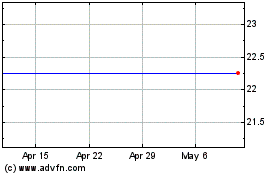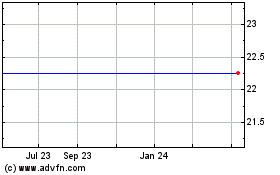Natural-Gas Prices Jump as Producers Promise Restraint -- Update
October 29 2019 - 5:21PM
Dow Jones News
By Ryan Dezember
Investors are rewarding energy companies who are promising to
produce less energy.
The producers that have glutted the market with cheap shale gas
are finally relenting, dialing back drilling plans and pledging
restraint after years of depressed prices battered their
growth-centric business models.
Investors drove shares of CNX Resources Corp. up nearly 16% on
Tuesday after the company told investors that it reduced drilling
activity this summer amid an unseasonable slump in natural-gas
prices.
The Pittsburgh-based company said it would spend 9% less than
originally planned in 2020, which in turn would decrease its
expected output by about 6%, helping to free up cash to pay back
debts coming due in 2022 and to buy back its shares.
"This is the signal investors have been waiting for," said
Welles Fitzpatrick, an analyst with SunTrust Robinson Humphrey.
CNX's assurances come after similar vows made last week by
rivals operating in Appalachia, including Range Resources Corp.,
Cabot Oil & Gas Corp. and Southwestern Energy Co., when each
disclosed their own third-quarter results.
Executives with all three of those companies said low gas prices
were prompting cutbacks and austerity. Should prices rise this
winter, they said that they are likely to use the extra cash to
continue buying back their beleaguered shares and to repay debt
rather than send drilling rigs into hills of Appalachia where they
have unleashed a market-swamping flood of natural gas. Shares of
the three companies have risen following the release of their
quarterly results and outlooks.
"Even with higher prices, I think there are a lot of
shareholders out there, including a lot of shareholders around this
table, that would like to see value come back to them as opposed to
just see growth for the sake of growth," Cabot Chief Executive Dan
O. Dinges told investors last week.
Such statements are already receiving a stiff test.
Natural-gas prices are on the rise, thanks to a huge cold front
forecast to sweep down over much of the country as well as
natural-gas producers who are yielding to depressed prices for the
heating fuel and dialing back production.
U.S. natural-gas futures for November delivery rose 6.2% on
Tuesday to $2.597 per million British thermal units. Gas for
December delivery climbed 3.3% to $2.639.
Those gains follow a 6.3% jump on Monday, which was the best day
for futures since January.
Forecasts predict a blanket of frigid temperatures over most of
the country during the first half of November. A cold front that
has already delivered freezing temperatures to Minneapolis and may
bring snow to Chicago before the end of the week is expected to
spark heating demand as far south as Atlanta and Houston, according
to weather service Maxar.
Sharp as the recent rise in prices has been, neither producers
nor analysts and investors anticipate prices pushing much higher or
sustaining weather-related gains.
Hedge funds and other money managers have built up a big bet
that prices will fall, with short positions outnumbering wagers on
rising prices by about three to one as of last week, according to
U.S. Commodity Futures Trading Commission data.
The short bet is approaching the size of one speculators made in
August, which was the largest net-negative wager on natural-gas
prices in more than a decade. The August short ended poorly when
prices shot up 25% in September on unseasonably steamy weather that
kept air conditioners running and demand for gas high.
Bank of America Merrill Lynch analysts last week lowered their
outlook for gas prices during the first quarter to $2.50 per
million British thermal units, down from $3, as well as their
forecast for all of 2020, during which they now expect natural gas
to average $2.35, down from $2.60.
A big reason besides sufficient stockpiles and robust production
that the analysts believe natural-gas prices will be limited is
that prices for Appalachian coal -- with which natural gas competes
as a fuel for power plants -- have collapsed. Down roughly 40% from
last year's highs, cheap coal will limit how high gas can rise
before electricity producers switch fuels, the Bank of America
analysts wrote in a note to clients.
Write to Ryan Dezember at ryan.dezember@wsj.com
(END) Dow Jones Newswires
October 29, 2019 17:06 ET (21:06 GMT)
Copyright (c) 2019 Dow Jones & Company, Inc.
Cabot Oil and Gas (NYSE:COG)
Historical Stock Chart
From Mar 2024 to Apr 2024

Cabot Oil and Gas (NYSE:COG)
Historical Stock Chart
From Apr 2023 to Apr 2024
